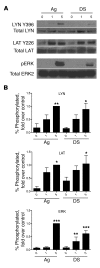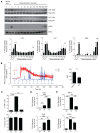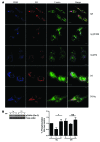Mast cell desensitization inhibits calcium flux and aberrantly remodels actin
- PMID: 27669462
- PMCID: PMC5096925
- DOI: 10.1172/JCI87492
Mast cell desensitization inhibits calcium flux and aberrantly remodels actin
Abstract
Rush desensitization (DS) is a widely used and effective clinical strategy for the rapid inhibition of IgE-mediated anaphylactic responses. However, the cellular targets and underlying mechanisms behind this process remain unclear. Recent studies have implicated mast cells (MCs) as the primary target cells for DS. Here, we developed a murine model of passive anaphylaxis with demonstrated MC involvement and an in vitro assay to evaluate the effect of DS on MCs. In contrast with previous reports, we determined that functional IgE remains on the cell surface of desensitized MCs following DS. Despite notable reductions in MC degranulation following DS, the high-affinity IgE receptor FcεRI was still capable of transducing signals in desensitized MCs. Additionally, we found that displacement of the actin cytoskeleton and its continued association with FcεRI impede the capacity of desensitized MCs to evoke the calcium response that is essential for MC degranulation. Together, these findings suggest that reduced degranulation responses in desensitized MCs arise from aberrant actin remodeling, providing insights that may lead to improvement of DS treatments for anaphylactic responses.
Figures









Similar articles
-
Cutting Edge: Drebrin-Regulated Actin Dynamics Regulate IgE-Dependent Mast Cell Activation and Allergic Responses.J Immunol. 2015 Jul 15;195(2):426-30. doi: 10.4049/jimmunol.1401442. Epub 2015 Jun 8. J Immunol. 2015. PMID: 26056254 Free PMC article.
-
Lipopolysaccharide suppresses IgE-mast cell-mediated reactions.Clin Exp Allergy. 2017 Dec;47(12):1574-1585. doi: 10.1111/cea.13013. Epub 2017 Oct 10. Clin Exp Allergy. 2017. PMID: 28833704 Free PMC article.
-
Ephedra Herb, Mao, Inhibits Antigen-Induced Mast Cell Degranulation by Induction of the Affinity Receptor for IgE Internalization.Pharm Res. 2021 Apr;38(4):569-581. doi: 10.1007/s11095-021-03020-0. Epub 2021 Mar 22. Pharm Res. 2021. PMID: 33754256
-
[Elucidation of Mast Cell Activation Mechanism Mediated by Purinergic Signaling].Yakugaku Zasshi. 2021;141(9):1057-1061. doi: 10.1248/yakushi.21-00113. Yakugaku Zasshi. 2021. PMID: 34471006 Review. Japanese.
-
Mechanisms of mast cell signaling in anaphylaxis.J Allergy Clin Immunol. 2009 Oct;124(4):639-46; quiz 647-8. doi: 10.1016/j.jaci.2009.08.035. J Allergy Clin Immunol. 2009. PMID: 19815110 Free PMC article. Review.
Cited by
-
Emerging Roles of Mast Cells in the Regulation of Lymphatic Immuno-Physiology.Front Immunol. 2020 Jun 17;11:1234. doi: 10.3389/fimmu.2020.01234. eCollection 2020. Front Immunol. 2020. PMID: 32625213 Free PMC article. Review.
-
Rapid desensitization of humanized mice with anti-human FcεRIα monoclonal antibodies.J Allergy Clin Immunol. 2020 Mar;145(3):907-921.e3. doi: 10.1016/j.jaci.2019.12.003. Epub 2019 Dec 11. J Allergy Clin Immunol. 2020. PMID: 31836406 Free PMC article.
-
Aberrant Activation of Mast Cells: Molecular Mechanisms and Targets for Intervention.Clin Rev Allergy Immunol. 2025 Jun 20;68(1):60. doi: 10.1007/s12016-025-09065-y. Clin Rev Allergy Immunol. 2025. PMID: 40542278 Review.
-
Biomarkers in oral immunotherapy.J Zhejiang Univ Sci B. 2022 Sept 15;23(9):705-731. doi: 10.1631/jzus.B2200047. J Zhejiang Univ Sci B. 2022. PMID: 36111569 Free PMC article. Review.
-
Cytoskeletal Transport, Reorganization, and Fusion Regulation in Mast Cell-Stimulus Secretion Coupling.Front Cell Dev Biol. 2021 Mar 16;9:652077. doi: 10.3389/fcell.2021.652077. eCollection 2021. Front Cell Dev Biol. 2021. PMID: 33796537 Free PMC article. Review.
References
-
- Simons FE. 9. Anaphylaxis. J Allergy Clin Immunol. 2008;121(2 suppl):S402–S407. - PubMed
Publication types
MeSH terms
Substances
Grants and funding
LinkOut - more resources
Full Text Sources
Other Literature Sources
Medical
Molecular Biology Databases

